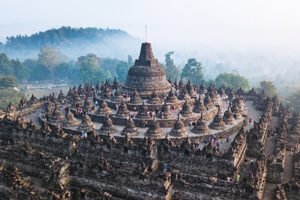History
The Sailendra dynasty built the largest Buddhist relics in the world between 780-840 AD. The Sailendra dynasty was the ruling dynasty at that time. This relic was built as a place of Buddhist worship and a place of pilgrimage. This place contains instructions for humans to abstain from worldly desires and towards enlightenment and wisdom according to the Buddha. This relic was discovered by British troops in 1814 under the leadership of Sir Thomas Stanford Raffles. The temple area was completely cleared in 1835.
Borobudur was built in the Mandala style which reflects the universe in Buddhist belief. The structure of this building is a box with four entrances and a circular center point. When viewed from the outside to the inside, it is divided into two parts, namely the natural world which is divided into three zones on the outside, and the realm of Nirvana in the center.
Zone 1: Kamadhatu
the natural world that is seen and is being experienced by humans today.
Kamadhatu consists of 160 reliefs that explain the Karmawibhangga Sutra, namely the law of cause and effect. Describes human nature and lust, such as robbing, killing, raping, torture, and slander.
The hood at the base has been permanently removed so that visitors can see the relief hidden at the bottom. A photo collection of all 160 relief photos can be seen at the Borobudur Temple Museum located in the Borobudur Archaeological Park.
Zone 2: Rupadhatu
transitional realm, where humans have been liberated from the affairs of the world.
Rapadhatu consists of a gallery of stone relief carvings and Buddha statues. In total there are 328 Buddha statues which also have reliefs on the carvings.
According to Sanskrit manuscripts, this section consists of 1300 reliefs in the form of Gandhawyuha, Lalitawistara, Jataka and Awadana. The whole stretches for 2.5 km with 1212 panels.
Zone 3: Arupadhatu
the highest realm, the house of God.
Three circular porticoes lead to the central dome or stupa representing the resurrection from the world. In this section there are no ornaments or decorations, which means it represents the highest purity.
The porch in this section consists of a circular stupa with holes, inverted bells, containing a Buddha statue that leads to the outside of the temple. There are 72 stupas in total. The largest stupa in the center is not as tall as the original version which has a height of 42m above the ground with a diameter of 9.9m. Unlike the stupa that surrounds it, the central stupa is empty and raises debate that there is actually content but there are also those who think that the stupa is indeed empty.
relief
Altogether there are 504 Buddhas with meditation postures and six different hand positions along the temple.
Temple Corridor
During restoration in the early 20th century, two smaller temples were discovered around Borobudur, namely Pawon Temple and Mendut Temple which are in line with Borobudur Temple. Pawon Temple is 1.15 km from Borobudur, while Mendut Temple is 3 km from Borobudur Temple. There is a belief that there is a religious relationship between the three temples, but the ritual process is still unknown.
The three temples form the route for the Vesak Day Festival which is held annually during the full moon in April or May. The festival commemorates the birth and death, as well as the enlightenment given by Gautama Buddha.
Reference : https://borobudurpark.com/temple/borobudur/


0 Comments